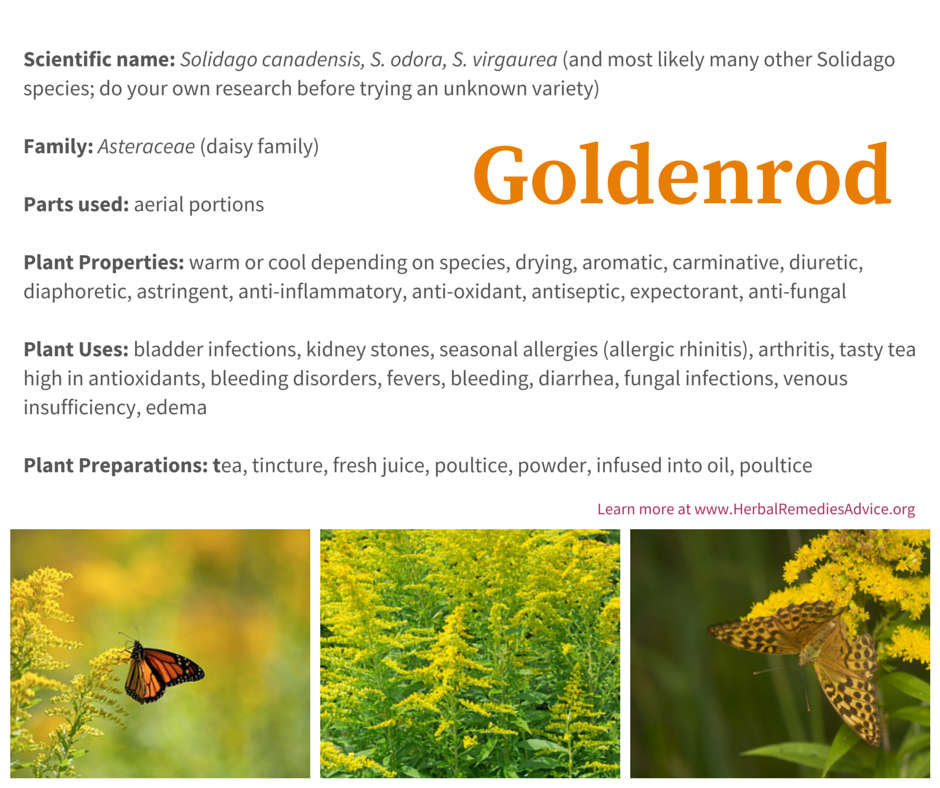Get weekly tips, recipes, and my Herbal Jumpstart e-course! Sign up for free today.
The Goldenrod Plant
Share this! |
|
In this episode, I’m sharing the 6 medicinal uses of the goldenrod plant in the Solidago genus. Far from being a likely culprit behind seasonal allergies, goldenrod is brimming with benefits, some of which may surprise you! (Plus I’ll also share what may be causing your seasonal allergies.)
Finally, as always, I love to share recipes that empower you to experience working with plants for yourself…and goldenrod is no exception. Be sure to download your free, printable recipe card for Goldenrod Tea for Urinary Support below.
When might you reach for goldenrod?
► To soothe sore muscles or pain from arthritis. In the episode, find out which herbalist (and former guest on this show) recommends goldenrod for “pains nothing else has touched.”
► To relieve seasonal allergies. (Surprise! Not only does goldenrod not typically cause allergies, it can actually play a role in alleviating allergic rhinitis or seasonal allergy symptoms.) You can find out the two herbs I like to pair goldenrod with for this purpose in the episode!
► To support heart health, capillary strength, and healthy circulation throughout the body. Who doesn’t want that? And a simple goldenrod tea is tasty, too…
These are just a few of the occasions when the uniquely pungent yet astringent goldenrod can be your ally… But there are more, so tune in to the entire episode for all the details on the many medicinal uses of the goldenrod plant!
After listening in, you’ll know:
► What type of infection the German Commission E has officially approved goldenrod to treat
► What type of preparation to use when working with goldenrod to address seasonal allergy symptoms and how to determine your best dosage
► The ideal time to harvest goldenrod for medicine-making
► When to drink goldenrod tea cold and when to drink it warm for best results
► and much more
-- TIMESTAMPS --
- 00:00 - Introduction to the goldenrod plant (Solidago spp.)
- 02:31 - Goldenrod energetics
- 03:47 - Goldenrod for the urinary system
- 05:25 - Goldenrod for seasonal allergies
- 06:47 - Goldenrod for muscle pain and arthritis
- 07:52 - Goldenrod for healing wounds
- 08:32 - A tasty tea high in antioxidants
- 10:36 - Goldenrod for relieving colds and the flu
- 11:30 - How to identify goldenrod
- 13:39 - Goldenrod plant preparations
- 18:32 - Herbal tidbit
Download Your Recipe Card!
l
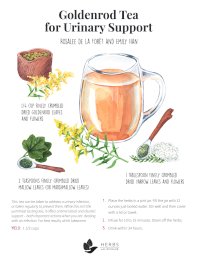
Transcript of the Goldenrod Plant Video
A lot of people despise the goldenrod plant because they mistakenly think it causes their allergies! Instead, there are many goldenrod benefits that will surprise you. This episode shares the medicinal uses of the goldenrod plant in the Solidago genus. I’ll specifically share 6 powerful goldenrod benefits. I’ll also share why this probably isn’t the plant causing you allergies (and what may be causing it instead).
When the tall spires of goldenrod begin to boast their yellow blooms I know it’s one of my favorite times of the year. Goldenrod flowers mean long days, hot weather and the refreshing feel of swimming in lakes and rivers. It also means the harvest season is on and it’s the perfect time to be foraging to enjoy the many medicinal uses of the goldenrod plant.
Goldenrod grows all over the world and many species are used as medicine. I recommend using local field guides or going on local native plant walks to find out what’s growing near you.
Do you have experience with goldenrod benefits? I’d love to hear about it in the comments on YouTube or at the bottom of this page. Your comments mean a lot to me! I love cultivating a community of kind-hearted plant-loving folks! Plus, it’s always interesting and insightful to hear the experiences of plant lovers out there. Your suggestion may also help others!
Okay, let’s dive in..
The Goldenrod Plant: Energetics
One of the best ways to get acquainted with goldenrod is through its taste and smell.
Whenever I find a goldenrod plant I like to crush a leaf between my fingers and spend a few moments appreciating its unique aromatics. After that, if I’m in an area that is safe to harvest, I also like to taste part of the leaf.
After doing this for many years I’ve really begun to appreciate the many flavors and nuances of goldenrod! Getting to know your local goldenrod can also help you to best use your specific varieties. For example, if it’s strongly astringent then the goldenrod benefits will be best for tightening lax tissues like leaky mucus or diarrhea.
Goldenrod is both a pungent and astringent herb. Its aromatics make it pungent, and, as you taste it, you can immediately get a feel for its astringent qualities.
One of the most pronounced medicinal uses of the goldenrod plant is for the urinary system and the upper respiratory system. It excels at tightening and toning tissue to stop excessive secretions.
The Goldenrod Plant for the Urinary System
The first goldenrod benefit is for the urinary system. And this isn’t something that’s new. Goldenrod has a long history of use for the urinary system. Herbalists regularly use it for urinary tract infections as well as for strengthening the kidneys. As mentioned, goldenrod is both astringent and antiseptic. By tightening and toning the tissues of the urinary system, as well as providing action against bacteria, goldenrod is well suited to addressing bladder and urinary tract infections.
Eclectic physicians used goldenrod for kidney stones in the 18 and 1900s and the German Commission E has officially approved goldenrod for the treatment of bladder and urinary system inflammations. Naturopathic doctor and urinary specialist Dr. Eric Yarnell recommends goldenrod for interstitial cystitis due to its inflammation-modulating abilities.1
There are so many medicinal uses of goldenrod for the urinary system!
One clinical trial found that an herbal formula including goldenrod, birch, and cranberry was able to significantly reduce the microbial colonization in patients with indwelling urinary catheters.2
Peter Holmes, herbalist and author of Energetics of Western Herbs, writes:
Goldenrod is one of the very few known trophorestoratives to the kidney organ. In any chronic kidney condition, this remedy is an indispensable asset and should be used long term.
The Goldenrod Plant for Seasonal Allergies
The second goldenrod plant benefit is for allergic rhinitis or seasonal allergies. I use it in many of my seasonal allergy tincture formulas (often combined with peach and plantain) and have seen it completely eliminate the itchy-red-eyes, runny-nose and excessive sneezing symptoms for many people.
Goldenrod also works really well for cat dander allergies. I typically recommend this as a tincture and suggest that people keep titrating up the dose until relief is found.
Many people despise goldenrod and blame it for their late summer and fall sniffles. However, the more likely culprit is ragweed which is the Ambrosia species.
Here’s why: Goldenrod is pollinated by insects, not by wind. As a result, its pollen is heavy and sticky and does not readily float through the air and thus into people’s noses to cause the offending symptoms.
Meanwhile ragweed is often blooming at the same time and, unlike goldenrod’s vivacious yellow blooms, it has inconspicuous flowers. So while goldenrod may catch our attention visually, ragweed’s wind-spreading pollen may be a more likely culprit.
The Goldenrod Plant for Muscle Pain and Arthritis
The third goldenrod benefit is for relieving pain.
In recent times goldenrod has gained popularity for relieving many different aches and pains from chronic arthritis to acute injuries. It can be infused into oil and rubbed into the painful areas for this purpose.
A couple of clinical trials have been done to evaluate Chilean goldenrod’s (Solidago chilensis) ability to address pain. In one study the topical cream was found to decrease the pain of people with tendonitis in the wrist and hand.3
Another study found that it decreased pain and increased flexibility in people with lower back pain.4
Henriette Kress, a fantastic herbalist who has been a guest on the podcast says this about goldenrod:
Goldenrod relieves most muscle aches. Try it for pains nothing else has touched. Give the oil a try for itches and swellings, too.
The Goldenrod Plant for Healing Wounds
The fourth goldenrod benefit is for healing the skin.
The name solidago means "to make whole." Historical references site using goldenrod poultices for healing wounds and for use on burns. I don’t see a lot of contemporary herbalists using it in this way and it seems like a great avenue to explore.
Herbalist Robert Dale Rogers shares this about goldenrod:
The fresh leaves make a good addition to burn salves, combining well with yarrow and plantain oils. The dry and powdered leaves make a good styptic agent for shaving cuts.
Goldenrod Tea Benefits: A Tasty Source of Antioxidants
The fifth goldenrod benefit is for modulating inflammation.
Goldenrod is very high in antioxidants.
Antioxidants are often called the key to good health and longevity. They can rid the body of free radicals, thus reducing the oxygenation of our cells.
Goldenrod is a good source of the constituent rutin. This flavonoid is well-known for its antioxidant benefits and is considered especially beneficial for heart health. Rutin can increase capillary strength and support healthy circulation throughout the cardiovascular system. It is also being studied for its ability to stop angiogenesis (and therefore the possibility of playing a role in stopping certain kinds of cancers).5 However, there have yet to be any clinical trials showing goldenrod’s abilities to address cancer.
Goldenrod’s high antioxidant levels may make it an ally for people with insulin resistance or type 2 diabetes, however there haven’t been any clinical trials to that effect and I haven’t heard of herbalists using it in that way. Another avenue to explore!
I love that one of the medicinal uses of goldenrod plant is to modulate inflammation. Plants that can help us with chronic inflammation are a really big deal!
Chronic inflammation is THE leading cause of most chronic diseases including heart disease, arthritis, back pain, skin conditions like eczema and acne, type 2 diabetes and so many more.
One of my passions is helping people figure out how to best work with herbs and lifestyle changes to powerfully reduce chronic inflammation so that they can finally address the root cause of their chronic illness.
I have a free training all about this called: How to Use Herbs to Transform Your Health to get More Energy & Vitality – Without Expensive Supplements or a Restrictive Elimination Diet.
You can access this free training at herb-training.com
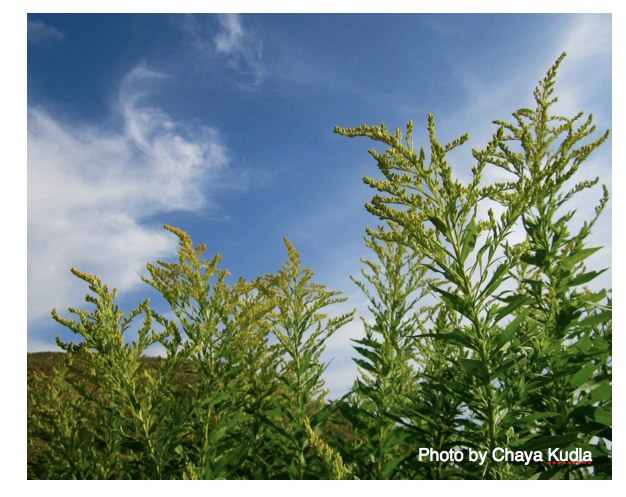 Goldenrod growing at Ancestree Herbals
Goldenrod growing at Ancestree HerbalsThe Goldenrod Plant for Relieving Colds and the Flu
The sixth and last goldenrod benefit is for relieving many symptoms during a cold or flu.
It’s a mild diaphoretic, helping to open the pores and release heat through the skin and therefore can support a person during a fever.
As an astringent and antimicrobial it can soothe a sore swollen throat - try it as a tea or infuse the fresh herb into honey.
It also helps to break up excessive and stuck mucous in the lungs, which can then be expectorated and expelled out of the body with more ease. Or, if there is too much leaky mucus in the nose, consider goldenrod to restore tone to the mucous membranes, thus stopping the excessive flow. Goldenrod isn’t always the first herb that people think of for symptoms of colds and the flu but I think it’s well worth trying out!
How to Identify The Goldenrod Plant
There are over 100 species within the Solidago genus. And many are commonly used in a similar manner. Each species has varying aromatics, tastes and therefore medicinal qualities. One species may be more bitter than the next, or more astringent. Herbalists can’t seem to agree on whether or not goldenrod is cooling or warming and I suspect this also has to do with species variation.
It can be very difficult to correctly key out Solidago species because they readily hybridize. Solidagos aren’t harmful; however, they can look like other potentially toxic plants (such as Senecio) so being able to correctly identify this plant is crucial. Consult with your local field guides and check with local sources to see if your local varieties have a history of use.
S. Canadensis is a perennial herb that can be grown easily from seed. It grows from rhizomatous roots and can reach up to 6 feet tall. It generally grows in clumps - which are often clones. Because of its tenacious growing patterns, it’s often not recommended to grow it in gardens. However, I’ve been growing it in my garden for several years and it seems to be doing fine.
The leaves grow opposite and are lance-shaped.
Goldenrod bursts into bloom in the later summer months. Its small yellow aster flowers grow at the top of the goldenrod spires in large clumps, showing off lots of color.
Goldenrod leaves and flowers are used for herbal medicine. Ideally, harvest the entire stalks (leaving behind some leaves) just before the plant blooms. If you harvest the plant while in full bloom, those yellow aster flowers will puff out as they dry.
 The leaves grow alternate and are lance shaped
The leaves grow alternate and are lance shaped The flowers are numerous and yellow and appear at the top of the stalk
The flowers are numerous and yellow and appear at the top of the stalk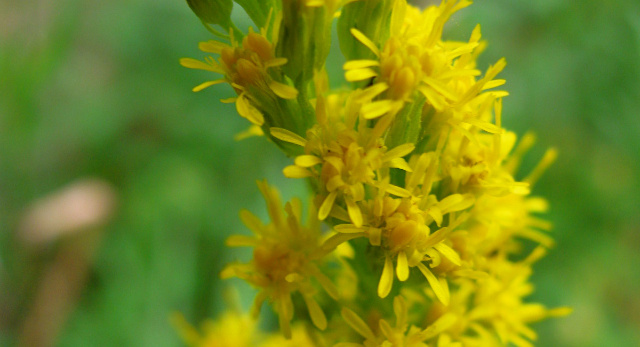 There are numerous small flowers on each stalk
There are numerous small flowers on each stalkGoldenrod Plant Preparations
Some people may have an adverse reaction to the goldenrod plant. It’s always best to consume small amounts when trying an herb for the first time.
Goldenrod tea is a tasty and effective medicine. The longer you brew it and the more herbs you use the stronger the medicine will be. For a pleasing beverage start with 1-2 teaspoons of goldenrod leaves/flowers per 8 ounces of water. Increase the steeping time and dosage as needed.
For more diuretic properties drink the tea cold. For more diaphoretic properties and to promote digestion, drink the tea warm.
Goldenrod can be formulated into different tea blends for different purposes. The following tea blend highlights the medicinal uses of the goldenrod plant for the urinary system.
Goldenrod Tea for Urinary Support
This tea can be taken to address a urinary infection, or taken regularly to prevent them. While this isn’t the yummiest tasting tea, it offers antimicrobial and diuretic support – both important actions when you are dealing with an infection. For best results, drink lukewarm.
Yield: 1 1/2 cups
- 1/4 cup finely crumbled dried goldenrod leaves and flowers
- 1 tablespoon finely crumbled dried yarrow leaves and flowers
- 2 teaspoons finely crumbled dried mallow leaves (or marshmallow leaves)
1. Place the herbs in a pint jar. Fill the jar with just-boiled water. Stir well and then cover
with a lid or towel.
2. Infuse for 10 to 15 minutes. Strain off the herbs.
3. Drink within 24 hours.
This recipe comes from our course, Rooted Medicine Circle. If you want to learn how to make potent herbal medicines from the plants that grow around you, then check out this ten-month online course which enrolls every January. In this community-based course we guide you, step by step, in making your own powerful herbal medicines in your own kitchen. Visit RootedMedicineCircle.com to get all the details and sign up for the waiting list.
If you enjoyed this video on the medicinal uses of the goldenrod plant and you value trusted herbal information, then I hope you’ll stick around! The best way to get started is to subscribe on YouTube and your favorite podcast app.
One of the best ways to retain and fully understand something you’ve just learned is to share it in your own words. With that in mind I invite you to share your takeaways with me and the entire Herbs with Rosalee community. You can leave comments on my YouTube channel, at the bottom of this page, or simply hit reply to my Wednesday email. I read every comment that comes in and I’m excited to hear your herbal thoughts.
Choose the best herb for you!
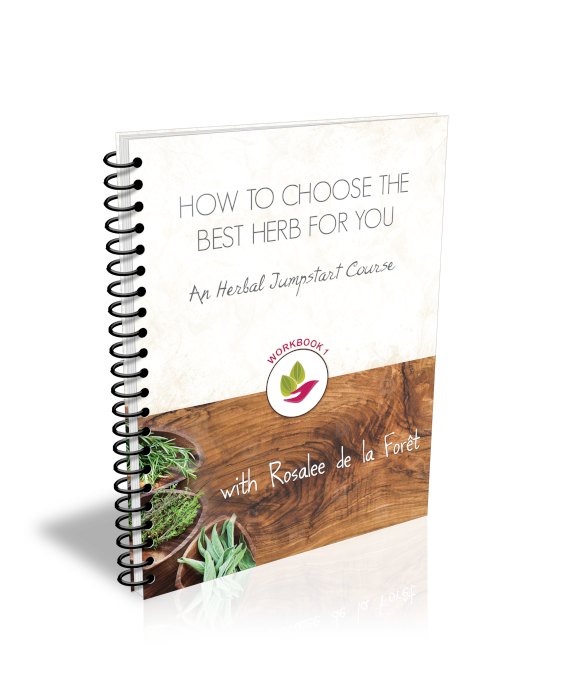
The secret to using herbs successfully begins with knowing who YOU are.
Get started by taking my free Herbal Jumpstart course when you enter your name and email address.
By signing up for my free course you’ll also be joining my weekly newsletter where I send my best tips and herbal recipes. I never sell your information and you can easily unsubscribe at any time.
Okay, you’ve lasted to the very end of the show which means you get a gold star and this herbal tidbit…
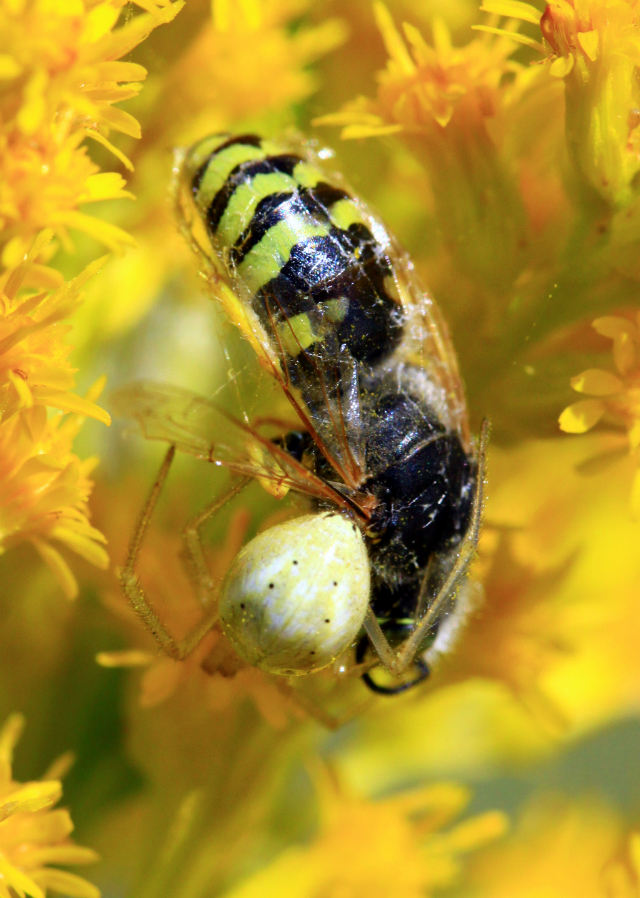 Photo taken by my friend and naturalist Bernie at Northwest Natural Moments
Photo taken by my friend and naturalist Bernie at Northwest Natural MomentsIf you hang out with goldenrod for very long, you’ll quickly become acquainted with the goldenrod crab spider (Misumena vatia). This spider turns yellow or white, depending on which flower it is inhabiting. Goldenrod also attracts many beneficial pollinators! As you can see from the photo, the goldenrod spider is a voracious hunter, often capturing and devouring pollinator insects three times its size. When I harvest goldenrod, I gently relocate many goldenrod spiders onto nearby plants.
Citations for the Goldenrod Plant
Click to show/hide.

Rosalee is an herbalist and author of the bestselling book Alchemy of Herbs: Transform Everyday Ingredients Into Foods & Remedies That Healand co-author of the bestselling book Wild Remedies: How to Forage Healing Foods and Craft Your Own Herbal Medicine. She's a registered herbalist with the American Herbalist Guild and has taught thousands of students through her online courses. Read about how Rosalee went from having a terminal illness to being a bestselling author in her full story here.

